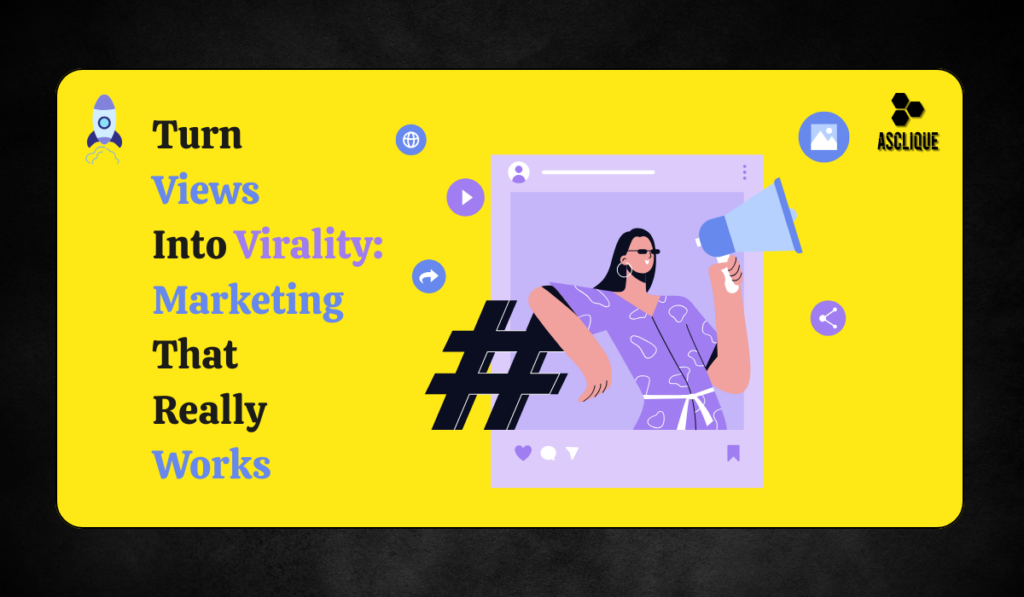Currently, marketing practices have shifted from the conventional advertisements to dynamic campaigns, which are fast spreading, especially in this hyper-connected world. One of them is viral marketing; a very modern approach in marketing, possessing a great advantage in promoting products, services, or ideas at lightning speed with the ability to fast share through society.
What is Viral Marketing?
Viral marketing is a term that refers to a software application or strategy in which one encourages an individual to forward marketing messages to another person, thereby spreading the reach of the message. The whole concept is driven by similarity to the virus spread.
Key Characteristics of Viral Marketing:
- Rapid mode of dissemination: Information travels very quickly through the platforms.
- User-generated: Involves users sharing and increasing content consumption.
- Cheap and cheerful: Minimal investment against expected massive exposure.
Types of Viral Marketing
| Type | Description | Example |
|---|---|---|
| Emotional Virality | Content that sparks strong emotional responses. | Dove’s Real Beauty campaign |
| Incentivized Virality | Rewards for sharing or referring. | Dropbox’s referral bonus |
| Humorous Virality | Funny content meant for entertainment. | Old Spice “The Man Your Man Could Smell Like” |
| Challenge-Based Virality | Participation-based trends. | Ice Bucket Challenge |
| Interactive/UGC Virality | User-generated content shared by fans. | TikTok dance challenges |
The Mechanics of Virally Marketing
Tapping into Reality
- Content that awakens emotional triggers within a person, whether that be happiness, surprise, emotion, or even anger, is likely to be shared more.
Emotional Engagement
- Content that triggers emotions—whether joy, surprise, awe, or even anger—is more likely to be shared.
Easy Sharing Mechanisms
- Inclusion of social media buttons, shareable formats (videos, memes, infographics), and referral links make spreading content easier.
Incentivization
- Referral rewards, giveaways, or discounts can motivate people to share the content.
Timing and Trends
- Aligning campaigns with trending topics, challenges, or cultural moments enhances shareability.
Viral Marketing Benefits
- Huge outreach: Campaigns can go worldwide in hours or days.
- Cost-efficient: Most of the marketing is done by the users themselves.
- Brand Awareness: Spreading like wildfire enhances visibility and recall.
- Credibility: Messages from friends/followers carry more weight than just brand advertisement.
Popular Examples of Viral Marketing
ALS Ice Bucket Challenge (2014)
- Raised over $115 million for ALS research.
- Combined a social challenge with charity.
- Used videos to encourage participation and sharing.
Dove’s Real Beauty Sketches
- Emotional storytelling around self-image.
- Touched hearts globally and encouraged social shares.
Old Spice’s “The Man Your Man Could Smell Like”
- Quirky humor and direct engagement with fans.
- Went viral through YouTube and social media.
Spotify Wrapped
- Personalized annual summaries of listening habits.
- Encouraged users to share their results on social media.
- Reinforces brand loyalty while attracting new users.
How to Create a Viral Marketing Campaign
Step-by-Step Guide:
1: Identify the Goal
- Is it brand awareness? Product launch? Website traffic?
- Define clear, measurable KPIs (e.g., shares, signups, mentions).
2: Know Your Audience
- What do they care about?
- What platforms do they use most?
- What type of content resonates with them?
3: Craft Shareable Content
- Use eye-catching visuals, strong headlines, or a compelling story.
- Keep it short, fun, and easy to digest.
4: Use the Right Channels
- Share on the platforms where your audience is active.
- Use hashtags, trends, and influencer collaborations to boost visibility.
5: Make Sharing Easy
- Add social sharing buttons.
- Use refer-a-friend programs or tag-a-friend CTA’s.
6: Monitor and Engage
- Track the campaign’s performance.
- Respond to comments and mentions to increase engagement.
Challenges and Risks of Viral Marketing
Viral marketing has its successes and potential to unleash all kinds of danger. But the hype can sometimes overshadow the risks and challenges associated with such a campaign. It is, therefore, essential to research, analyze, and comprehend the risks associated with potential backfire into the campaign. Let’s take a look at the major drawbacks of viral marketing:
Unpredictability and Lack of Control
Challenge:
Viral campaigns are unpredictable by nature. Content that has been artfully crafted may fail to go viral, then the brand merely loses some degree of control over how the message travels after release. What works once may never work again.
Why It’s Risky:
- Uncertain outcomes: Virality depends on various factors like timing, social trends, and audience response.
- Message distortion: The content may be interpreted differently from what was intended or completely out of context.
Mitigation:
- Testing content on smaller groups.
- Continue to monitor how things unfold and change plans where necessary.
Backlash And Negative Virality
Challenge:
Virality can often backfire, triggering a negative reaction that tends to spread faster than a positive one. Content that is inopportune or downright offensive may cause public backlash against your brand, thus tarnishing its image.
Why It Is Risky:
- Negative sentiments spread fast: Once a negative sentiment takes root in the public, there is no stopping it.
- Cultural sensitivity: Ignoring audiences on the microscale or offending them will act as a catalyst for bigger criticisms.
Mitigation:
- Ensure cultural mitigate in messaging.
- Keep an eye on possible grounds for complaints and react swiftly.
Short Lifespan of Viral Campaigns
Difficulty:
Most viral campaigns will not last beyond the first buzz, and their attention will fade quickly. This pushes viral content to make sustaining the conversation difficult.
Risk:
- Short-lived attention: Just because it’s an instant viral moment does not mean it should last for years with the brand.
- Diminishing returns: As the novelty wears off, so too does the excitement.
Mitigation:
- Follow-on campaigns: a continued succession of related content to maintain the momentum.
- Diverse content to sustain beyond the viral moment.
Over Saturation of Content
Challenge:
When a particular content is overexposed, fatigue starts to set in among the audiences. If content goes viral and then is either repeated endlessly or too widely spread, it will lose its capabilities and attract nothing but the disengagement of the audience and annoyance.
Risk:
- Repetitive content: The same message or format may bore audiences.
- Diluted impact: Too much saturation might make the whole thing feel somewhat inauthentic.
Mitigation:
- Reduce the number of times the content is allowed to go out.
- Find new angles to keep your audience interested.
Scalability Problems
Challenge:
With viral trends come sudden spikes in demand; demand that very few brands are able to meet. Whether it be website traffic, orders, or customer support: every sudden rise in demand can result in an overwhelming number of casualties for your systems.
Risk:
- Operational strain: Your infrastructure may struggle to handle the increased volume.
- Customer dissatisfaction: Delays, outages, or poor service can hurt your brand’s reputation.
Mitigation:
- Make sure that systems, logistics, and customer service are prepared for such increased demand.
- Keep your customers in the loop when possible: alert them about changes, delays, and risk factors.
Metrics for Measuring Success
| Metric | Why It Matters |
|---|---|
| Reach & Impressions | How many people saw the content |
| Shares & Mentions | Indicator of virality and organic spread |
| Engagement Rate | Comments, likes, retweets, saves |
| Traffic Sources | Where the viral traffic is coming from |
| Conversions | Signups, downloads, purchases |
| Media Coverage | PR and brand visibility generated |
Conclusion
Viral marketing is a combination of science, psychology, creativity, and timing. Going viral is never guaranteed, but brands that understand their audience, speak to their emotions, and create content that invites conversation greatly increase the odds. Real power is in the hands of the common consumer-turned brand ambassador.
From establishing a startup to the growth of a global brand, viral marketing, when carried out well, will redefine your reach and reputation—without burning a hole in your pocket.
FAQs
Can any content go viral?
Only emotional, relatable and easy-to-share really matters for reaching super viral potential.
Is viral marketing expensive?
Not really; a lot of the really great viral campaigns have been low-budget, but high on creativity.
How long does viral content last?
Usually only for a few days or weeks before the public loses interest.
Does viral mean more sales?
Not automatically; virality increases awareness but sales depend on your strategy and the right fit of your product.
Best platforms for viral marketing?
The best of the best for a fast, extensive sharing are TikTok, Instagram, YouTube, and X (Twitter).

